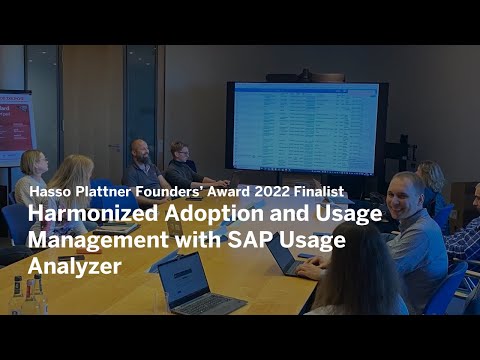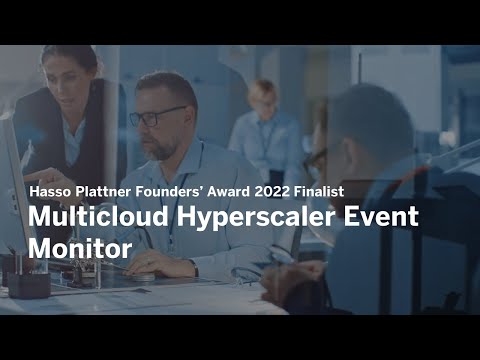Nine teams across three categories — each reflecting a different type of breakthrough thinking, considering the various ways in which innovation drives SAP’s success — are competing for this year’s Hasso Plattner Founders’ Award.
Here, meet the finalists in the Operational Excellence category.
The Hasso Plattner Founders’ Award is the highest
employee recognition at SAP, awarded annually by the CEO
to an individual or a team.
Finalist: Harmonized Adoption and Usage Management with Usage Analyzer
How many customers have adopted an SAP solution? How many of them are using which functionality? Answers to those and many other questions around adoption, consumption, and usage can now be found more easily.
In the past, harmonized usage data and KPIs were not available. Insights were only available in silos and high manual efforts were required to create a holistic view of customers’ usage behaviors, which resulted in missed opportunities to generate additional revenue and value.
Unwilling to accept the status quo, a cross-functional team initiated the Harmonized Adoption and Usage Management project. Together they established a standardized framework for scalable and sustainable functional usage measurement. This included the design, rollout, and execution of usage metering standards, along with central data collection leveraging state-of-the-art technologies. Ultimately, Usage Analyzer was developed, providing a 360-degree view of cloud customers and public cloud products.

Video by David Aguirre
As of today, the Usage Analyzer has been successfully rolled out to select customer-facing roles, solutions, and product and portfolio management teams. More than 75% of the enabled group are regularly working with it.
Usage Analyzer provides intuitive, role-based, and concise views into the way customers adopt and consume SAP products. The Customer Success organization leverages these usage insights to prepare customer meetings, drive adoption campaigns, and perform intelligent goal planning based on usage patterns. Product and solution management teams make use of this data to prioritize their investments and to monitor product adoption and release success.
What’s next on the team’s list? They continue to engage with business experts to expand the integration of usage insights into day-to-day activities and operations. The continuous growth of harmonized telemetric data points across cloud solutions from SAP will remain a key focus. Furthermore, the Harmonized Adoption and Usage Management team is evaluating possibilities to display usage information and KPIs along end-to-end processes to illustrate and highlight the value that SAP software provides to customers.
Finalist Fast Facts
- Submission Title: Harmonized Adoption and Usage Management with Usage Analyzer
- Team: Martin Guenther, Natascha Pluecken, Carmen Fuhlbruegge, Martin Layer, Rainer Hillebrand, Denise Schmidt, Raquel Torrents, Iva Stojcic, Richard Grandpierre, Thorsten Broszies
- Number of employees: 10
- Achievement: The Usage Analyzer provides transparency on harmonized adoption and usage insights on SAP’s cloud customer base, across all cloud products and all aligned with business practices
- Impact: Harmonized usage insights positively impact renewals and product investments, and reduce manual efforts.
Finalist: Multicloud Hyperscaler Event Monitor
Prior to the development of Multicloud Hyperscaler Event Monitor, responses to public cloud outages were reactive.
“A lack of real-time, relevant data made collaboration across incident management and problem management teams a challenge,” explains David Cruickshank, vice president of Multicloud DevOps at SAP, GCS Multicloud.

Video by Esteban Villate
But Multicloud Hyperscaler Event Monitor delivers a continuous feed of events for all hyperscaler services consumed by SAP cloud accounts and users.
By pulling health event data from hyperscaler service health APIs, the team provided an aggregated view of public cloud outages across AWS, Azure, and Google Cloud Platform. The hyperscaler data is enriched with metadata from multicloud internal proprietary systems, bringing additional context — including the name of the line of business responsible for the cloud account and the cloud accounts that are hosting production systems.
As a next step, the team correlated the data from support tickets raised by SAP lines of business with hyperscalers in order to accelerate confirmation of impact and lower mean time to resolve.
Process for Centralized Public Cloud Services
The team went on to automate identification of service-level agreement (SLA) violations by monitoring SLA performance for the hyperscalers’ platform services. The SLA violations are published on a dedicated dashboard and SLA credit requests are raised automatically with hyperscalers.
Additionally, a risk report highlighted that SAP historically had not initiated claims for SLA credit from public cloud provider partners after outages impacting SAP services. The team was tasked with mitigating this and implementing a centralized SLA credit claiming service.
“As more SAP-critical platforms, applications, and data come to rely upon the infrastructure and services of public cloud providers, SLAs represent a commitment to customers to meet fundamental operating requirements,” Cruickshank shares. “The Multicloud Hyperscaler Event Monitor provides an automated, accurate, and centralized service, filing SLA claims on behalf of lines of business when hyperscaler commitments fail.”
The enriched data brings early awareness and visibility to teams that need it during public cloud provider outages. This is especially relevant for mission-critical services like the medical industry and government agencies.
Finalist Fast Facts
- Submission Title: Multicloud Hyperscaler Event Monitor
- Team: David Cruickshank, Richard Bolan, Gerry McPhillips, Darren Chambers, Eimear O’Hare, Joey Lee, Abhishek Yadav, Xander O’Dempsey, Chandradhar Alla
- Number of employees: Nine
- Achievement: First-ever central aggregated view of service health events and support tickets across AWS, Azure, and Google Cloud Platform. The centralized monitoring of hyperscaler platform services has resulted in identification of hyperscaler SLA violations through automation and successful SLA credit claims for lines of business.
- Impact: Enhanced visibility and awareness during hyperscaler service outages for SAP lines of business, central incident response teams, and other key stakeholders, contributing to reduction in mean time to resolve for incidents and increased operational excellence through early awareness of incidents. Successful identification and raising of SLA credit claims, helping ensure that SAP can run more efficiently in the public cloud.
Finalist: CMI Crystal Ball
What if every single SAP seller and marketer had a crystal ball that gave them unique, data-driven insights into their customers’ in-moment buying interests and strategic needs?
The majority of customers’ buying journey has now become digital, a trend that has only accelerated post-COVID-19. Customers are more empowered than ever to explore, learn, and find solutions — all online. CMI Crystal Ball was built with one simple goal: to listen to customers’ needs within their digital journey to serve them in compelling and predictive ways.

Video by Matt Dillman
Built by passionate data enthusiasts from across the CMI and IES Infused Intelligence teams, the CMI Crystal Ball platform injects billions of external digital signals from various data vendors. A common taxonomy model allows that data to seamlessly “talk” to each other. Finally, sophisticated patent-pending scoring algorithms driven by artificial intelligence (AI) are applied to predict exactly which companies SAP should prioritize by use case.
Empowering Every Employee with Data-Driven Customer Insights
Starting with 50 pilot users in North America, the excitement has grown to well over 7,000 active users worldwide. And the underlying data graph has grown just as fast, now covering all 1.3 million accounts in CRM plus 10 million more outside CRM.
This had also led to a wave of grassroots ingenuity from customer teams all over the world that are applying CMI Crystal Ball in an ever-expanding list of use cases, including prospecting, cross and upsell, net-new logos, competitive attack, digital activation, events, renewals, and churn.
“As an AI-driven platform designed to listen to customers’ needs, CMI Crystal Ball is truly unique in the market,” says Paul Logue, head of SAP CMI. “Enabling SAP with data-driven insights on our customers — well before our competition — can set us apart in our ability to serve our customers’ most precise needs.”
Finalist Fast Facts
- Submission Title: CMI Crystal Ball
- Team: Paul Logue, Franklin Herbas, William Doyle, Roja Saidi, Shreerang Javadekar, Susanne Beckers, Christoph Kommer, Damien Garnier, Behroz Sikander, Wei-Yi Chen
- Number of employees: 10
- Achievement: The team’s achievements are recognized through broad adoption, with 7,000 users per quarter, as well as significant business impact. Externally, CMI Crystal Ball has received several industry awards from leading sales and marketing organizations (IDG, ITSMA, CIO 100) and has two pending patents (SuperScore, Topic Networks).
- Impact: Crystal Ball supercharges account engagement as measured by website clicks and registrations, a 6x to 39x increase, and major event registrations, 546 new to SAP TechEd 2022. In progressing and closing business, accounts with high predictive scores have 2.9x larger deal values and $210 million revenue influenced in Outreach.io.



